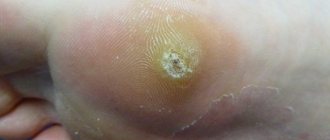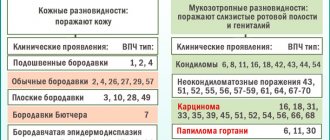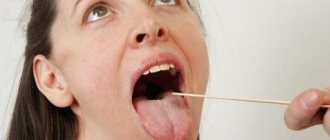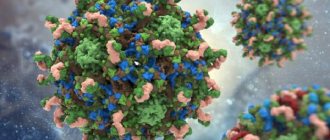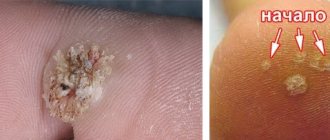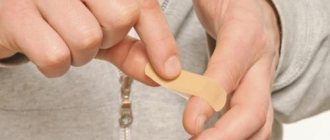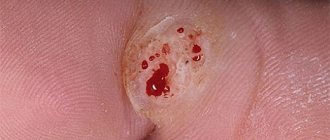Why do periungual growths appear?
They are almost standard benign neoplasms that everyone has, but their localization is special and, as everyone has already guessed from the name, the location of such warts is near the nails.
But not only near, but also under the nail plate itself, on the hands and feet. These formations are caused by the papilloma virus type 2 and belong to vulgar warts.
As mentioned above, any warts are caused by HPV. It, in turn, is activated due to weakened immunity, any stressful situation or chronic disease.
In addition, periungual warts can form as a result of skin microtraumas around the nail. Most often, this disease affects people who constantly bite their nails, carelessly remove cuticles, and work without gloves in an aquatic environment.
Also, such growths can appear in children who constantly suck their fingers.
What is a wart under the nail?
The wart under the nail is initially very small and practically does not differ in color from the skin, so it is noticed when it begins to grow and cause inconvenience to its owner.
A subungual wart is a benign neoplasm caused by the human papillomavirus. Neoplasms are localized in the area of the nail plate, while the arms and legs suffer to the same extent.
On the hand, such neoplasms are more noticeable and cause great moral discomfort to their owner. However, they do not cause pain, itching or burning, so these formations are considered to be more of a cosmetic defect.
Reasons for appearance
The main reason for the appearance of warts of any location, type and shape is infection of the body with the human papillomavirus (HPV).
There are more than a hundred types of HPV, while some types are harmless, while others can cause the development of neoplasms with a high risk of malignancy.
How does infection occur?
Papillomavirus has a contact route of transmission.
Infection is possible through microcracks, cuts and scratches on the skin through direct (kiss, handshake, hug) or indirect (through railings, handrails, personal hygiene items) contact with the carrier.
Photo: infection can occur through a handshake
Almost 90% of people on the planet are carriers of papillomavirus, but with strong immunity, external manifestations of carriage do not develop.
Warts appear only when the immune system malfunctions and in many cases disappear on their own when its functioning normalizes.
- The constant presence of the pathogen in the body provokes relapses in the development of warts under the nails, even with their successful treatment.
- If the removal is inadequate, the tumors may spread to other areas of the skin.
Factors provoking development
Factors that give rise to the formation of warts include:
The human papillomavirus causes warts to appear on our skin. In principle, despite the scale of the spread, and almost every eighth inhabitant of the planet suffers from the virus, warts are considered benign neoplasms that do not cause serious problems for humans.
photo of periungual warts and papillomas (initial stage)
Reasons for the occurrence of neoplasms of this type
The main cause of warts is human infection with the papilloma virus. The specific strain that causes the appearance of periungual warts is present in the blood of almost every person. The main factors provoking the active activity of the virus are:
- A weakened immune system, which is observed against the background of chronic diseases.
- If a person frequently comes into contact with water.
- Disturbances of the endocrine system.
- Constant stress, overwork.
- Weakening of the body due to an acute infectious disease.
- Permanent or frequent damage to the skin around the nail plate: violations of the integrity of the skin, cracks, injuries.
A subungual wart with hardened roots causes pain when pressing on the nail.
Mechanism of infection
The habit of biting nails is one of the causes of nail warts.
According to statistics, every third inhabitant of the earth is a carrier of the papilloma virus, without even knowing it. A pathogenic agent entering the body may not manifest itself for a long time.
As soon as a patient develops subungual warts, this indicates that the body has hormonal imbalances, an exacerbation of chronic diseases, or a significantly weakened immune system. Other causes of warts near or under the nail plate include:
- bad habits (biting nails, scratching cuticles);
- damage to periungual tissues during manicure (the risk increases if the master works with dirty tools);
- increased sweating of hands.
It is very easy to become infected with the papilloma virus: it is transmitted not just through sexual contact or oral sex, but even through kissing and microscopic injuries on the skin or mucous membranes.
Among the main routes of infection are places such as:
- public swimming pool, shower, bathhouse, sauna;
- through a handshake;
- in a manicure or massage salon;
- self-infection through skin injuries.
Types of warts
In most cases, the following types of warts are diagnosed on the skin of the feet and palms, in the area of the fingers, near and under the nails:
- vulgar (simple) - have a rough surface, round or spherical shape. Their size does not exceed one centimeter. Distinctive features are the multiple nature and localization mainly on the dorsum of the arms and legs;
- flat - this type of neoplasm is quite rare (in about 4 out of a hundred cases) and is a formation slightly raised above the skin, having a flat top, and most often an irregular shape. A distinctive feature is the absence of excessive keratinization, which ensures the smoothness and shine of the surface of the wart. Usually a flat wart forms on the back of the hands, in most cases there are several of them;
- plantar - this term rather refers to the location of the tumor. A plantar wart is a wart located on the surface of the foot. These are very painful neoplasms because they are constantly under stress when walking. Warts can spread to the fingers and the periungual area of the skin of the feet.
- periungual - neoplasms that develop on the toe or hand, near and under the nails. The growths may be superficial or have a root located deep under the nail.
Periungual wart treatment at home
Beautiful skin is a sign of good health of the body.
Any changes in the skin, the appearance of rashes, inflammation and other disorders indicate a weakening of the immune system.
Warts on the hands are no exception; their appearance signals that the human papillomavirus (HPV) has entered the bloodstream, which is actively multiplying and becoming a source of infection for other people.
- All information on the site is for informational purposes only and is NOT a guide to action!
- can give you an ACCURATE DIAGNOSIS !
- We kindly ask you NOT to self-medicate, but to make an appointment with a specialist !
- Health to you and your loved ones!
What is this
Periungual warts are benign growths that do not pose a serious threat to health.
They are classified as vulgar growths and are most often caused by a type 2 virus.
As the name suggests, warts affect the cuticle skin around the nail plate, under the fingernails and toenails, and are not a very pleasant sight.
Therefore, the desire to get rid of such neoplasms is more caused by an unaesthetic appearance, and not by the danger of their transformation into a malignant tumor, as is the case with warts of other localizations.
Varieties
There are many types of warts, the growth of which is caused by HPV.
In medicine, it is customary to distinguish 5 types:
- vulgar or ordinary growths that rise above the skin, gray or yellowish in color with a rough surface. Thanks to the root, they grow into the deeper layers of the skin, which makes them difficult to remove on your own. They can appear on the back of the hands and fingers in children and adults. Often one wart can multiply, leading to the appearance of several;
- flat, youthful or juvenile warts appear mainly in adolescents during puberty, have a smooth surface, a gray tint, and often grow on the face and neck in multiple quantities;
- filamentous neoplasms or papillomas have a stalk and a hanging elongated shape. They often grow in the armpits, on the chest of old people, under the mammary glands of women. They are soft to the touch, easily injured, have a flesh-colored or pinkish color;
- Senile or seborrheic warts take years to form and appear as large dark brown or black growths with an oily and wrinkled surface. Appears in older people on the back, neck, face and scalp;
- genital warts are considered the most dangerous type, and also differ in where they spread. They grow on the outside of the genitals in men and women, on the lining of the vagina, infect the opening of the anus, and are a common cause of cervical and penile cancer.
Why do they appear?
the cause of the disease is a virus. Once in the body, HPV can lie low for a long period without showing its presence.
The habit of biting nails is one of the reasons for the appearance of warts
Every third person on earth is a carrier of the virus, without even realizing it.
The appearance of warts indicates negative changes in the body, weakened immunity, progression of concomitant diseases, changes in hormonal levels, and frequent stress.
Also provokes the growth of warts:
- increased sweating of hands;
- damage to the cuticle due to injury or during manicure;
- frequent contact with water without gloves;
- habit of biting nails.
Methods of infection
transmission of the virus occurs through close contacts
- The virus is very easy to contract and is transmitted from person to person most often through sexual contact, including oral sex and kissing.
- The virus is so small that it enters the bloodstream through microscopic injuries in the skin or mucous membrane.
You can become infected with HPV:
- in the pool, bathhouse, public shower;
- in a nail salon, if the tools are not sufficiently disinfected;
- by shaking hands;
- by self-infection due to injuries to the skin around the nail.
Clinical manifestations of periungual warts
HPV infection of fingers
- The shape of the neoplasms is flat or resembles a hemisphere.
- The growths are rough to the touch, can grow on the surface of the periungual space or have a root, merging with each other.
- Typically, warts do not cause discomfort, do not hurt or itch.
Despite the fact that periungual warts are not dangerous, their long-term presence in a person can create serious problems:
deformation and destruction of the nail plate
- gradual thinning, deformation and destruction of the nail;
cracks on the finger
- the formation of cracks, which can become a gateway for various types of infections to enter the body;
- damage to a wide surface caused by the proliferation of warts through the entry of the virus into microcracks in healthy skin.
Diagnostics
For diagnosis, an examination by a specialist is sufficient, who in rare cases decides to send the wart tissue for histological examination to ensure that it is benign.
visual examination by a dermatologist
Additionally, the blood is tested to determine the presence of HPV in the body.
Treatment
A periungual wart is only a symptom of a disease, the treatment of which consists primarily of fighting the virus, as well as strengthening the immune system.
The doctor prescribes antiviral and immunomodulatory drugs (Acyclovir, Panavir, Viferon, Genferon, Immunomax, Likopid), as well as vitamin and mineral complexes.
How to use “Cryopharma” wart remover? Find out here.
However, treatment with topical antiviral ointments rarely brings results.
The growths must be removed to prevent their spread and preserve the health of the nail plate.
Removal
Removing periungual warts can be difficult due to their location.
removal with radio knife
There are several methods that are used in modern medicine:
- excision with a scalpel is rarely used, it leaves visible scars, and there is also a high probability of relapses, but it is effective for large growths when other methods cannot be used;
- electrocoagulation involves applying an electric current to the wart. The tissues are heated, destroyed and the dead growth is removed with a special loop. The crust formed at the cut site disappears on its own, leaving no scars;
- burning out warts with a laser is effective and occurs layer by layer through the targeted action of a heat beam, prevents infection, is bloodless, and rarely leaves scars, reduces the risk of relapses;
removal of tumors with laser
- cryodestruction - freezing the wart with liquid nitrogen, during which the tissues die and fall off. This method does not require pain relief or time, but to completely get rid of growths you need to attend several sessions. Nitrogen removal is contraindicated in children under 4 years of age, pregnant women and patients with diabetes.
cauterization with liquid nitrogen
External signs and symptoms
A nail wart forms on the fingers or toes and is located very close to the nail plate or even under it itself. The external signs of such a disease are familiar to absolutely everyone and they look like this:
- a small formation in the form of a hemisphere;
- yellowish or brown color of the formation, sometimes, no difference between the color of the growth and the skin;
- not too dense growth, which has a fairly deep root.
With an external inspection, problems can be identified immediately. If you touch the growth or try to press on it, the person will not experience any painful or other uncomfortable sensations.
The appearance of warts is caused by the human papillomavirus
Symptoms and diagnosis
Diagnosing a wart under your nail is not as easy as it might seem at first glance.
A wart under a fingernail or toenail belongs to the group of vulgar skin growths. Their distinctive feature is that they grow next to the nail plate or directly under it. In their shape, they can be in the form of a hemisphere with a rough, rough surface on top or flat. The most common type is subcutaneous nail condylomas with roots extending far under the plate. Their removal causes a number of difficulties and is accompanied by a long rehabilitation period.
Expert opinion
Sakania Luiza Ruslanovna
Dermatovenerologist, cosmetologist, trichologist
Ask a Question
A subungual rough wart does not cause physical discomfort to its owner, but it is a serious cosmetic defect. Often people avoid contact and handshakes with patients because of their disgust and other similar feelings.
In most cases, people consider nail warts not dangerous and do not fight them in any way, but this is a completely misunderstanding of the problem.
Growths can lead to:
- To infection of surrounding healthy tissues. Viruses and bacteria penetrate through microcracks and injuries. Such damage occurs due to wearing tight shoes, biting hangnails, nails, etc.
- Thinning of the nail plate.
Only an experienced doctor can conduct a reliable diagnosis and carry out professional removal of periungual warts. It is important to perform a histology analysis after excision of damaged tissue to identify the presence of malignant cells that can cause cancer.
A periungual wart has an unusual location, and treatment is complicated because of this. Not a single ointment or medicinal solution is able to penetrate the epicenter of the growth. Clinical removal is often the only option.
External signs and symptoms
Nail warts come in different shapes (spherical or squamous). They have a rough surface and are flesh-colored or grayish. Quite often, warts have a so-called “root”, which is located deep in the nail, which makes it much more difficult to remove.
Warts on the finger: causes, treatment
Wart on the phalanx of the finger
Causes of warts on hands
Benign skin formations are often caused by the pathogenic human papillomavirus, which affects the human body, the upper layer of skin and causes not only physical discomfort, but also psychological discomfort. Infection with the virus can be contact, transmitted through household means, through microtraumas, skin wounds. The virus can live in the human body for a long time without causing much discomfort, but provoking factors and decreased immunity contribute to the reproduction and progression of the virus, resulting in growths in the form of warts appearing on the skin.
Periungual wart photo
Warts have several varieties and can affect not only human skin, but also mucous membranes, which significantly worsens the course and treatment of the disease. Generally, warts can appear in adolescence, during hormonal changes, also in people with neurological diseases, and with reduced immunity, the risk of warts increases.
The most common warts are common or simple, which affect the hands, elbows, fingers, causing cosmetic defects and other psychological disorders. Warts are very contagious and when they see growths on their hands, many people avoid contact with people, which causes a number of complexes. Warts are completely painless, but they can become inflamed, grow, and bleed when injured, which causes pain.
The main cause of warts is the presence of human papillomavirus in the body. There are more than 100 stamps of this virus, but warts on the fingers are caused by virus No. 2 or No. 4. There are also several provoking factors that contribute to the progression of the virus and the formation of growths:
- Reduced immunity;
- Frequent stress, depression;
- Hormonal disorders;
- Excessive sweating;
- Failure to comply with hygiene rules;
- Contact with a sick person;
Very often, warts are observed in people who cut fish and meat.
Symptoms of the appearance of a neoplasm
Common or vulgar warts are most often found on the fingers; they are considered the most harmless, but as they progress, they can multiply and appear on the elbows, neck and other areas of the skin. Sometimes a viral wart on the finger multiplies and affects the anterior sections of the mucous membranes of the mouth, the extreme corners of the border of the lips, the tip of the tongue, or the outer corners of the mouth. Such warts have a pointed shape in the form of an acute pale pink papilla. The growths are capable of merging and forming vegetations; they also have rounded, clear edges rising above the skin level.
Common warts, often appearing on the back of the hand or fingertips, are round papules of varying sizes. The surface of such warts is uneven, dry, covered with villi and small cracks. With constant trauma, they can become inflamed and cause pain. Most often, vulgar warts are localized between the fingers, on the back of the hand, and on the upper hands. If a wart is on the pad of a finger or under the nail plates, a person feels pain when doing any work, and such growths are often injured.
How to recognize a wart
Consequences of wart removal
Warts are small growths with papillary-shaped formations of keratinized skin of a brown or grayish tint. Such warts have a dense structure of a round or oval shape. To the touch, the growths are rough, hard and have multiple black dots inside. The sizes of ordinary warts range from 5 mm to 1-1.5 cm. Warts on the hands are completely painless, but if the growths are located under the nail plates of the fingers, then the person feels severe pain.
Also, a wart on the thumb has an aesthetic drawback; it often becomes damaged, can grow, change shape or color. If warts are on the hands for a long time, they begin to darken. Warts can be single or multiple; also, if there are several growths on the skin, between them there should be the largest one, which is called the “maternal” one. Very often, after its removal, all warts disappear on their own. The appearance of warts is directly related to the internal state of health, so in order to get rid of warts, the cause of their occurrence should be removed.
Methods of treating the disease
Warts very rarely disappear on their own; they can remain unchanged for a long time and multiply, causing great cosmetic discomfort. There are a large number of methods for dealing with skin growths, but before removing them, it is important to consult with a dermatologist who can rule out a malignant neoplasm resembling a wart.
Warts can be removed using medications, laser, cryotherapy and other methods.
Medications:
CryoPharma is an effective medicine for removing warts at home by freezing. The drug is completely identical to the method of removing warts using liquid nitrogen. To remove a wart, usually only 1 procedure is required, but if the growths have been on the skin for a long time, then 2 to 4 procedures will be needed. After treating a wart with CryoPharma, the growth disappears within 10 to 14 days. Initially, a dry crust forms, which can be easily removed after a few days. The area where the wart was should be treated with a disinfectant solution for several days. A detailed description of the drug can be found in the instructions for use. Collomak is a medicinal product for removing warts of various etiologies. The drug has a pronounced keratolytic, antiseptic and anti-inflammatory effect. The drug is used externally, 1-2 drops on damaged areas of the skin. Allowed for use by children over 1 year old. It is not recommended to use the drug for more than 7 days. Solcoderm is an effective remedy for removing warts on the hands and other areas of the skin. After using the drug, the growth disappears after a few days. Solcoderm is a potent drug and its use is recommended under the supervision of a doctor. The dose of the drug is prescribed individually for each person.
All medications for wart removal are used topically and also have contraindications and side effects. Therefore, taking into account the individuality of each organism, before use you should consult a doctor or read the instructions for use. Along with the use of topical agents, the doctor prescribes immunostimulating therapy and vitamin therapy, which can strengthen the immune system and prevent the re-formation of warts.
Laser or liquid nitrogen is widely used to remove growths, which are the most effective, less traumatic and safe for humans. If there are several warts on the fingers, then the doctor looks for the largest one, which is called the “mother” after its removal, all growths disappear on their own. Only a dermatologist can select a method for removing warts after examining the growth and taking an anamnesis.
bad-skin.ru>
Diagnostics
In order to accurately determine the problem and begin its proper treatment, a person who suspects that he has a periungual wart should consult a doctor.
Without knowing the severity of the problem, it is strictly forbidden to self-medicate and simply try to pick off a wart. The first step is to contact a dermatologist who can correctly diagnose the problem using the following techniques:
- external examination of the problematic area of skin;
- conducting tissue analysis of a new formation to find out whether it is benign;
- use of additional medical research techniques.
Photo: examination by a doctor
Diagnosis of subungual warts is not difficult and consists of the following steps:
- examining the damaged area of the skin and determining whether there are signs of an inflammatory process;
- if the development of a malignant neoplasm is suspected, part of the tissue is sent for histological examination, confirming or rejecting malignancy with a high probability;
- In some cases, it is necessary to additionally test for the type of papillomavirus, since each type can cause certain types of warts.
Before treating warts in a child, you should consult not only a dermatologist, but also an immunologist, to determine the activity of the immune system and adjust its functioning.
photo of warts and papillomas under the fingernail
Periungual warts can be treated in different ways. To remove them, both physiotherapeutic procedures and medications and traditional medicine methods are used.
Periungual warts: causes and treatment
A periungual wart is a benign growth (growth) on the skin around the nail plate (occasionally it may appear under the nail itself).
Periungual warts are a type of common wart; they often form in the area next to or under the nail plate. This disease has a viral etiology and is manifested by the formation of papules (nodules) on the surface of the skin, protruding above the epithelium.
Such tumors are benign formations, but in some cases they can degenerate into malignant ones. The appearance of periungual warts is caused by the penetration of the human papillomavirus (HPV), which has up to 100 different types, into the body.
Mostly children who suffer from relapses have the bad habit of biting their nails and the skin around them.
Papillomas that form near the nails are usually divided into two types:
- arising under the nails - subungual;
- those formed on the surface of the cuticle near the nail plate are pre-nail or periungual.
The first ones are localized under the nail; the nodules are small in size and practically do not differ in color from the skin. Most often, such warts are not noticed because they do not cause any problems.
Trouble begins only when the subungual papule formed under the nail increases in size and continues to grow. In this case, the nail gradually becomes thinner, which leads to its deformation and, as a result, destruction.
It is also noted that periungual warts on the feet begin to cause severe pain due to the fact that the foot is compressed by shoes. This leads to the fact that the patient begins to limp and his mobility will inevitably be limited.
Therefore, if such a pathology exists, it is recommended to consult a specialist to make a diagnosis and choose the right treatment.
A periungual or periungual wart is a wart that has formed on the hands or feet near the nail itself. Such a papilloma is almost immediately detected by the patient, since it is a tumor on the surface of the epithelium, rising more or less above its level.
A wart of this type has a flat outline or may have a root that extends deeply into the tissue. Papillomas with the root, increasing in size, begin to capture the nearby growing nail, which causes its damage.
As a result, its surface is distorted and it is gradually destroyed.
If you examine periungual warts in detail, you will notice tiny dots and stripes on their surface, which indicate the appearance of blood clots in the capillaries.
Nail warts on the hands are often injured. This causes the papule to begin to bleed. In this case, autoinoculation occurs, that is, the patient becomes self-infected.
It is important to note
that subungual or periungual warts appear much less frequently than other types.
Causes of periungual warts
The photo shows a neglected periungual wart
As mentioned above, the cause of the occurrence of such papillomas is infection with HPV, which penetrates through microtraumas in the skin.
This could be an accidental injury, a manicure performed in violation of sanitary standards (cuts or the use of an infected instrument), contact with a carrier of the disease, or the use of things of a person infected with HPV.
The virus itself can enter the human body even in childhood, but not manifest itself until “favorable” conditions are created for it:
- general decrease in immunity;
- presence of hangnails;
- habit of biting nails and cuticles;
- working without protective gloves with household chemicals or chemicals that irritate the skin on the hands.
These are the factors influencing the formation of periungual warts on the hands. If we talk about papillomas under the nail plate on the toes, their appearance can be caused by:
- wearing someone else's shoes;
- lack of special shoes in saunas or swimming pools;
- wearing tight, uncomfortable shoes made of rough or non-breathable materials;
- increased sweating on the feet;
- presence of ingrown toenails.
Diagnosis and symptoms of periungual warts
If warts have formed near the nail plate or under it, then they can very easily be confused with the characteristic features of other diseases.
Therefore, it is recommended to consult a dermatologist who can correctly diagnose the tumor and prescribe appropriate treatment to eliminate papilloma. Self-medication in this case can lead to negative results.
A competent specialist, after examining the skin and neoplasms on it, will quickly make a diagnosis. Occasionally, doctors prescribe additional tests to eliminate the risk of developing cancer.
Periungual warts look very much like calluses. However, the main difference between a callus and a papilloma is that the skin pattern is preserved on the surface of the former and thrombosed capillaries are not visible in its structure. But on the surface of the papules black specks are clearly visible. This is easy to notice even with a visual inspection.
When a wart forms under the nail plate, gradual destruction of the nail occurs , and this is very similar in appearance to a fungal infection. If we compare the photos presented in many literary medical sources, the pathologies are completely indistinguishable in appearance. In this case, it is necessary to sow mushrooms. If the patient has HPV, it will test negative.
If necessary, the dermatologist may additionally recommend undergoing:
- Dermatoscopy. During the procedure, a dermoscope device is used, which displays the surface of the formation at tenfold magnification. Structure, symmetry and contours become more clearly visible.
- Biopsy.
In this case, tiny parts of the skin nodule are taken for examination under a microscope.
Treatment of periungual warts: pharmaceutical preparations
Traditional medicine offers several treatments for periungual warts. They are usually divided into two groups - conservative treatment and surgical intervention.
Conservative therapy refers to the prescription of medications that fight HPV and help improve immunity. Usually these are medications for oral administration. The most effective of them:
- Cycloferon - price starts from 135 rubles;
- Anaferon - from 198 rubles;
- Isoprinosine
- cost starts from 587 rubles.
You should not take these medications for self-medication. Only a specialist can prescribe them based on the clinical picture of the disease. In some cases, dermatologists recommend topical treatment.
Products for external use are prescribed depending on how many warts appear, what their size is and where they are located.
The list of the most effective medications for external use includes:
- Imiquimod (from RUB 2,019) is an immunomodulator.
- Solcoderm (price varies from 401 to 1,489 rubles) and Verrukacid
(from 211 rubles) are acid-based medications that promote tissue necrosis. - Viferon (from 123 rubles) - antiviral ointment.
- Cryopharma (from RUB 859) is a refrigerant that freezes warts.
- Salicylic acid (price from 6 rubles) and Collomak
(price ranges from 264 to 490 rubles) are keratolytic agents that destroy the stratum corneum of papilloma.
The doctor prescribes all of the above medications for the treatment of small periungual warts that are located on the surface of the skin. If the papilloma is large, has a deep root or is an old formation, then it is recommended to resort to surgery.
Source: https://dermatologys.ru/lechenie-vzroslyh/92-okolonogtevye-borodavki-prichiny-i-lechenie.html
Treatment options
Getting rid of periungual growths caused by human papillomavirus infection is quite difficult. This is due to the fact that the roots of the formation often go deep under the nail plate and are inaccessible to local influence.
In addition, treatment is often complicated by the fact that the wart may not form next to the nail, but directly under it. In any case, the process of removing benign formations in the area of the nail plates is always complex and lengthy.
Laser removal of periungual warts is considered the most effective method. Its advantages:
Treatment is complicated by the fact that such warts are located extremely inconveniently. Lesions must be combated not only on the skin, but also in the subungual space, which is much more difficult to achieve.
Among the main therapeutic measures are the following:
For periungual warts, treatment involves the following therapeutic methods:
Drug
Treatment of periungual warts with medications at the initial stage involves the use of external agents (ointments, extracts, creams and herbal preparations) to get rid of the benign neoplasm.
The most popular external treatments are:
- Super clean;
- Verrucacid;
- Salicylic acid;
- Solcoderm;
- Lapis pencil.
All of these drugs should be used only after consulting a doctor, since many of them contain alkalis and acids, which should not come into contact with healthy tissue and can cause undesirable consequences.
Hardware
This method of treatment is maximally effective and involves getting rid of tumors using the following methods:
Laser coagulation
Using this method, you can completely remove a subungual wart, followed by smoothing of the skin within 3-4 weeks. Laser cauterization is performed in layers, and for complicated warts it is carried out in several sessions.
This method of getting rid of benign tumors is considered the most aesthetic, which is explained by the absence of scar tissue and extremely rare relapses of the disease.
Cryotherapy
Removing growths by freezing them with special equipment. This method is quite effective, but is absolutely contraindicated for treating children, pregnant women and patients with diabetes. In addition, after cryotherapy, scar tissue may form;
Electrocoagulation
This method of treating skin tags helps prevent bleeding and infection. Warts are removed using high-frequency electric rays.
Each of these methods is selected individually, depending on the severity of the nail damage and the patient’s condition.
Chemical
Chemical preparations (Verrukacid, Ferezol, Panavir, Kolomak, Viferon, etc.) to remove tumors in the nail area are used extremely rarely and require the mandatory participation of a doctor so as not to cause damage to healthy skin.
Surgical
The surgical method of removal involves classic excision of the tumor, covering the entire affected area, since a wart under the nail is quite difficult to excise.
Their removal is difficult due to the specific location, so the surgical method is used in cases where the growth cannot be removed using all of the above methods.
Surgery is extremely traumatic and requires anesthesia and a long healing period.
It must be remembered that subungual warts must be treated, especially if they have changed their color or there is rapid growth, as well as an inflammatory process with suppuration of the subungual area.
Photo 3. Treatment is complex, so as soon as you notice hints of infection, immediately contact a cosmetologist
Unfortunately, periungual warts are difficult to treat. This is why it is so important to consult a doctor in a timely manner, and this should be done as soon as you suspect that you have an incipient periungual wart.
Regardless of what method of treatment the doctor prescribes for you - cryotherapy, laser surgery or some other treatment - be prepared for the fact that it will drag on for a long time.
Features of treatment
Treatment of periungual warts can be carried out using several methods:
- Medicines.
- Folk remedies.
- Through surgery.
Folk remedies
Folk remedies for warts must be used with caution, mainly all remedies for external use
At the moment, there are many formulations that are an excellent addition to official medicine. Traditional medicines should not be used as independent therapy.
Such remedies are very helpful in the early stages of the disease, when the roots of the wart have not yet penetrated deeply enough. How to get rid of periungual warts according to the recommendations of traditional medicine:
- Celandine juice. An effective product that must be applied to the wart in such a way as not to touch healthy areas of the skin. If used incorrectly, burns may occur, so caution should be exercised. The procedure is performed twice a day until the growth turns black and falls off.
- Alcohol tincture of calendula. Used for wiping morning and evening for 14 days.
- Iodine solution. The product is applied with a cotton swab so as not to touch healthy skin. The procedure is performed twice a day. The course of treatment is two weeks.
- Juice of garlic or onion. The substance should be applied to the affected area three times a day.
- Freshly squeezed apple juice. If used daily, it can get rid of warts within two weeks.
Drug therapy
Treatment with medications is determined by a specialist based on a thorough diagnosis. The course of therapy is prescribed individually depending on the patient’s condition. Successful treatment consists of the complex use of drugs from the following groups:
- bactericidal;
- antiviral;
- with pronounced immunomodulatory properties.
One of the most popular options for treating periungual warts is the drug Isoprinosine. It is used in conjunction with vitamin complexes, allowing you to eliminate warts relatively quickly.
Cosmetology and physiotherapeutic procedures
The cryotherapy process involves exposing periungual warts to very low temperatures, as a result they are destroyed and disappear, the risk of reappearance is minimal
If taking medications does not give the desired effect, the specialist may prescribe the following procedures to the patient:
- Laser therapy. This is a physiotherapeutic technique that is very popular in cosmetology and dermatology. At the moment it is considered one of the most popular and safe methods of treating warts. It is used not only for adults, but also for children. The procedure involves directing radiation to the affected skin areas.
- Cryotherapy. A cosmetic procedure that involves applying cold directly to the affected skin. Absolutely painless and very effective. Liquid nitrogen is used, the use of which virtually eliminates relapses.
Surgery
This is a rather painful procedure, so it is performed under anesthesia. The operation is performed in extreme cases when other methods are powerless. Its main disadvantage is the possibility of scar formation as a result of suturing the excised areas.
During surgery, periungual warts are removed using a scalpel. If the growth was not completely cut out, then the likelihood of relapse increases significantly. If hygiene is not observed during the operation, blood poisoning may occur.
Folk remedies for removing nail growths
Traditional methods of treatment involve the use of plants that have a burning juice that destroys warts.
Photo: using fresh plant juice
Such plants include celandine, spurge, and dandelion. Pure plant juice can be applied to the new growth, which must be done extremely carefully, otherwise burns may occur.
Treatment with folk remedies can be carried out using the following recipes:
- vinegar compress - add a few drops of 80% vinegar essence to a small amount of wheat flour and mix thoroughly until a thick dough forms. A lump of dough is applied to the wart, excluding healthy skin in order to avoid burns;
- garlic ointment - carefully chop a clove of garlic and mix it with an equal volume of Vaseline or natural butter;
- onion compress - onion pieces are soaked in 6 or 9% vinegar and applied to the wart.
Before getting rid of a wart using traditional methods, you should consult a doctor.
Photo: treatment of tumors with garlic
Self-medication can cause damage to the neoplasm and give impetus to its malignancy.
Unfortunately, many people do not like to go to doctors and prefer to remove skin tags on their own. We don't recommend doing this.
Treatment methods for periungual warts
Skin growths create aesthetic problems and indicate problems in the body.
A periungual wart is not a dangerous neoplasm, but it spoils the appearance and gives rise to complexes. The reasons for the appearance of growths lie in infection with the human papillomavirus.
When the immune system weakens, it becomes more active. Proper treatment will remove the growths and prevent their reappearance.
Clinical picture
Periungual warts manifest themselves in different ways. There are flat and pointed, smooth and lumpy growths. If the formations have a rough surface, the risk of secondary infection increases. Fungus and coccal infections thrive in such tissues.
Apart from external manifestations, there are no symptoms. In rare cases, itching is possible, and sometimes the nail plate becomes thinner and destroyed. This symptom indicates the rapid development of the disease. It is necessary to get rid of growths, cleanse the body and strengthen the immune system. This will reduce the activity of the virus.
Extensive damage is possible if the skin around the fingers cracks and peels. Tissues are vulnerable to pathogenic microflora, which means that it is impossible to do without antiseptics and increasing the protective functions of the skin.
What causes warts to appear?
If HPV is the culprit in the appearance of tumors, then why does it not always make itself felt, since many people are carriers? A sharp weakening of the immune defense contributes to the spread of warts. The appearance of formations around the nails is preceded by:
- frequent cuticle damage and secondary infection;
- interaction with household chemicals and aggressive environments without gloves;
- habit of biting nails;
- nail extensions and a passion for long-lasting varnishes that make nail breathing difficult;
- hyperhidrosis of the palms;
- burns, ulcers and other defects of the epithelial layer.
If other neoplasms have already appeared on the skin, then it is necessary to pay increased attention to hand hygiene. In case of microtraumas, the skin must be treated with an antiseptic.
Treatment options
Therapy must be comprehensive. This will stop the virus from the inside and remove growths from the outside. The treatment is carried out by a dermatologist. He selects drugs for oral administration and prescribes an adequate method of destruction of formations.
Traditional medicine methods
Cryodestruction
Treatment of periungual warts involves mechanical removal of growths. Antiviral drugs, as a rule, do not give the desired result, and only surgical treatment eliminates skin defects. To remove periungual warts, the following are recommended:
- Electrocoagulation is a safe and reliable method that gets rid of growths in one session. The minimal rehabilitation period and the absence of scars after the crust falls off speak in favor of electrocoagulation.
- Cryodestruction - the method has many advantages: ease of implementation, minimum contraindications, no need for pain relief. But if the periungual warts are large, then it will not be possible to get rid of them at once.
- Laser removal is one of the most common surgical methods. Eliminates relapse and allows you to remove the growth without blood and with minimal risk of infection.
- Radioknife is a modern method of wart destruction. Comparable in efficiency to laser and has the same advantages. It is not used for skin diseases accompanied by malignant tumors.
- Removal with a scalpel. If the wart is localized deeply and has a large diameter, then you will have to resort to a scalpel, although this method is inferior to the previous ones. The procedure takes longer, as does the recovery period. To avoid infection, the skin around the nail is treated with antiseptic agents until complete healing.
https://www..com/watch?v=aqWMqT8ZADU
Additionally, antiviral drugs with an immunostimulating effect are prescribed. Affordable and safe drugs include Cycloferon and Panavir. Isoprinosine has proven itself well.
It inhibits the human papilloma virus and in some cases allows you to get rid of overgrown tissue without surgical treatment. A complete review of the product and recommendations for use will be given by your attending physician.
ethnoscience
If a small wart appears on a finger, folk recipes will help. Traditionally, homemade ointments and solutions are used to treat growths. If the treatment methods suggested by the doctor do not give the desired result, time-tested recipes will help out:
- Vinegar - it is diluted with flour to a creamy state, distributed over the surface of the warts, waited until completely dry and secured with a band-aid. Repeat every day before bed for a month.
- Celandine - both fresh juice and pharmaceutical preparation are used for medicinal purposes. Treatment is carried out twice a day. After a few weeks, the growth dries out and the wart seems to shrink. The complete period of death of pathogenic tissue is determined by its size.
- Aloe juice - this remedy is equally suitable for external use and for oral administration. If the formations are located nearby, they can be covered with an aloe leaf, cut inward, and secured on top with a bandage or plaster.
Treatment with folk remedies should not be the main one. But it will enhance the effectiveness of medications and prevent exacerbation.
Traditional medicine for papillomas under the nail
You can also get rid of periungual papillomas using traditional medicine methods:
treatment of warts with celandine juice
- Celandine juice has been and remains an excellent remedy against warts. Regular lubrication of papillomas with this juice leads to their complete disappearance.
- You can also prepare a product based on vinegar essence and glycerin. Add vinegar essence to a bottle of pharmaceutical glycerin, shake and lubricate the affected areas.
- You can also prepare garlic ointment. To do this, you need to grate the garlic on a fine grater and mix it with melted lard in a 1:1 ratio.
- Some apply aloe or kalanchoe paste to sore spots, wipe warts with essential oils based on tea tree or lemon.
Periungual warts, even after they are completely removed, may reappear. To prevent this, you need to strengthen your immune system, take care of your diet, personal hygiene, walk in the fresh air, and avoid nervous strain.
Areas that have been affected by warts should be regularly wiped with a solution of acetic acid. By following these tips, you can forget about such formations as periungual warts.
Good health.
Why do growths appear under the nail - subungual and periungual warts? Methods for removing them
Periungual warts are a type of common neoplasm and are a growth under or near the nail. Such skin lesions can be located on both the legs and arms of a person. They have a rough surface and a flat or hemispherical shape.
Periungual warts - photo:
The presence of warts is not accompanied by any pain, itching or other negative sensations. This type of benign neoplasm can rather be called a cosmetic defect. But a wart under the nail is not completely harmless. Its presence can cause such consequences as:
- depletion of the nail and its further destruction;
- the occurrence of re-infection if bacteria and viruses enter cracks in the growth.
Reasons for appearance
The cause of periungual warts is the papilloma virus. It is transmitted through contact with a carrier or through the use of shared objects. However, infection with the virus does not necessarily cause the formation of a tumor. The virus can remain dormant for an extended period of time.
The virus begins to actively develop when:
- weak immunity;
- handling stress;
- exacerbation of chronic diseases.
Also, the appearance of warts may be preceded by skin microdamages around the nail. The risk group consists of people who bite their nails, often work with water without gloves, carelessly remove cuticles, and are characterized by increased sweating. Infection, as well as viral spread, occurs very quickly in this category.
Getting rid of such a disease is not easy. If you seek medical help from a dermatologist in a timely manner, the treatment process for periungual warts will be faster.
Removal of periungual warts is carried out using the same methods as when removing other types of them, but this will take much more time, which is due to the inaccessible location of their roots for the use of mechanical action and the tendency of such growths to relapse.
Methods for treating periungual and subungual warts
- Cryotherapy is a method involving the use of liquid nitrogen at a temperature of 196 °C. Exposure of the wart to cold promotes the destruction of epithelial cells, kills the virus and eliminates the wart. This method is gentle, but it has contraindications for children under 4 years of age, people with diabetes and pregnant women. The effectiveness of cryotherapy is 70-100%, the risk of relapse is 15%.
- Laser treatment. When using a laser beam, skin lesions are removed layer by layer under local anesthesia. At the site where the wart was removed, a small depression remains, which levels out after a while. The effectiveness of this method is 60-93%, relapses do not occur.
- Electrocoagulation. This technique involves removing the tumor using a loop of the finest wire under high-frequency current. Its effectiveness reaches 80-95%.
- Removal is surgical. This method is used if the wart is located under the nail or if there is a large area of skin damage. The method gives results in 50-60% of cases, the possibility of relapse is 50%.
Despite the effectiveness of methods for removing growths, some of their consequences may occur - the appearance of scars as a result of laser therapy, the formation of blisters after the use of liquid nitrogen, allergies to various acids and chemotherapy drugs.
Sometimes just removing the wart is not enough. In such a situation, the doctor focuses on all kinds of antiviral and immunomodulatory drugs.
Treatment of periungual skin injuries should be accompanied by supervision by a specialist. You should not self-medicate, as this can only temporarily stop their development, aggravate the situation and lead to nail loss.
Video: removal of a periungual wart.
Conclusion. If skin trauma occurs during cuticle removal, it is necessary to treat the damaged area with hydrogen peroxide in order to prevent the penetration of the virus, as well as its further development.
kozhnyi.ru>
Risks and preventative measures
If a person ignores a periungual wart, he runs the risk of expanding the range of his own diseases, encountering a fungus and forever being left with unsightly nails. It is because of this that the problem must be dealt with competently and in a timely manner, but it is better to avoid it altogether.
In this case, preventive measures can be considered:
Post Views: 3,406
Surgical removal
A periungual wart can be removed surgically. In this case, the surgeon uses a scalpel to excise the tissue of the benign tumor. If necessary, the removed structures are sent for histological analysis to the laboratory.
It is worth noting that this technique is rarely practiced in modern medicine. The fact is that a scar often forms on the treated area. In addition, after the operation the wound heals for quite a long time. There is a high risk of tissue infection with the development of bacterial and fungal complications.
Kinds
Papillomas appear due to a viral infection or due to age-related changes in the skin. Popular types of warts that are located around or under the nails are vulgar or juvenile papillomas.
Ordinary papillomas are dome-shaped and have a dirty-brown color. Simple warts look like the top of a cauliflower. Small solitary papillomas tend to merge and form large, lumpy papillomas.
The juvenile type of warts differs from the flat type in that they have the appearance of a node, are grayish-yellow in color, and can often be grouped in the event of an abrasion or cut.
Conservative treatment
This technique involves the use of local drugs and oral administration of immunostimulating and antiviral drugs.
Since warts occur against the background of viruses, taking drugs that suppress them is completely justified.
Today, the pharmaceutical industry offers a wide range of drugs that can combat papillomavirus: Cycloferon, Isoprinosine and others.
In parallel with these drugs, immunostimulants are usually prescribed, since the virus is activated only if the immune system is weakened. However, without consulting a doctor, it is not recommended to use such drugs on your own.
If a subungual wart has appeared recently, does not have deep roots and is large in size, then you can get rid of it using external means.
These can be keratolytic drugs, for example, Collomak or salicylic ointment. Acid-based ointments and gels that have a necrotizing effect are also used: “Verrukacid” and “Solcoderm” or refrigerants “Cryopharma”.
In therapy, for example, “Resorcinol” can be used, which is classified as an antiseptic with the active substance meta-dioxybenzene. However, this drug should not be used together with salicylic acid, sodium bicarbonate and magnesium oxide. "Resorcinol" is not recommended for use in adolescence, during hormonal maturation.
One of the effective external remedies for warts is Feresol. This liquid contains phenol and tricresol. It can only be used in a medical facility. When applying it, treatment of healthy layers of skin is not allowed. If the growth has a leg, then only it is lubricated. Keratinized warts are pre-steamed in a water bath. The maximum number of treatments with this drug is 5 times.
It is also necessary to understand that if the roots and large growths are too deep, they will have to be removed surgically.
Question answer
- How can you get infected?
It is very easy to become infected with papilloma. You just need to shake the hand of an infected person, touch the same object.
- What causes infection?
The papilloma virus penetrates under the skin or onto the mucous membrane of the victim. The infection enters the tissue layer that is located under the skin, after which the virus easily enters the human nervous system. As a result of all this, the papilloma virus settles in the body forever.
—Are these warts dangerous?
In many situations, warts under or near the nails cause only cosmetic discomfort and may disappear without any treatment in 2-3 years. But any wart is dangerous in its own way, as it causes the appearance of a malignant tumor.
Cryodestruction: features of the technique
Cryotherapy today is one of the most popular and effective methods for removing periungual warts. The essence of the procedure is simple - pathologically altered tissues are treated with liquid nitrogen. When exposed to ultra-low temperatures, wart cells are destroyed.
After the procedure, a blister (burn) forms on the skin, which goes away on its own after a few days. This is an accessible technique, and its cost is relatively low. However, sometimes small scars remain on the treated areas of the skin.
Surgery
However, local drugs do not always help; in extreme cases, you will have to resort to radical methods of treatment, namely surgery. If we are talking about excision with a scalpel, then only a surgeon can perform such an operation. After the operation there is a long rehabilitation period. There is also a huge risk of scarring, so surgery is rarely recommended.
After the operation, a scar will remain, and the wound itself will take a long time to heal. But under any circumstances, the scar will be less noticeable than the wart itself.
Prevention: Can warts be prevented?
Of course, it is much easier to try to prevent such tumors from occurring than to then worry about treatment. Prevention in this case is very simple:
- It is important to adhere to proper nutrition, take vitamins, exercise, strengthen the body, in a word, maintain the normal functioning of the immune system.
- Experts recommend adhering to the rules of personal hygiene, properly caring for nails, skin of hands and feet, and using appropriate soap and cream.
- It is very important to trim your nails correctly. If you are planning to get a manicure or pedicure, then choose only trusted professionals and be sure to ask for information about how they sterilize their instruments.
- Be sure to wear shoes that fit properly. Give preference to socks made from natural fabrics.
By following these rules, you can significantly reduce the risk of developing periungual warts.
